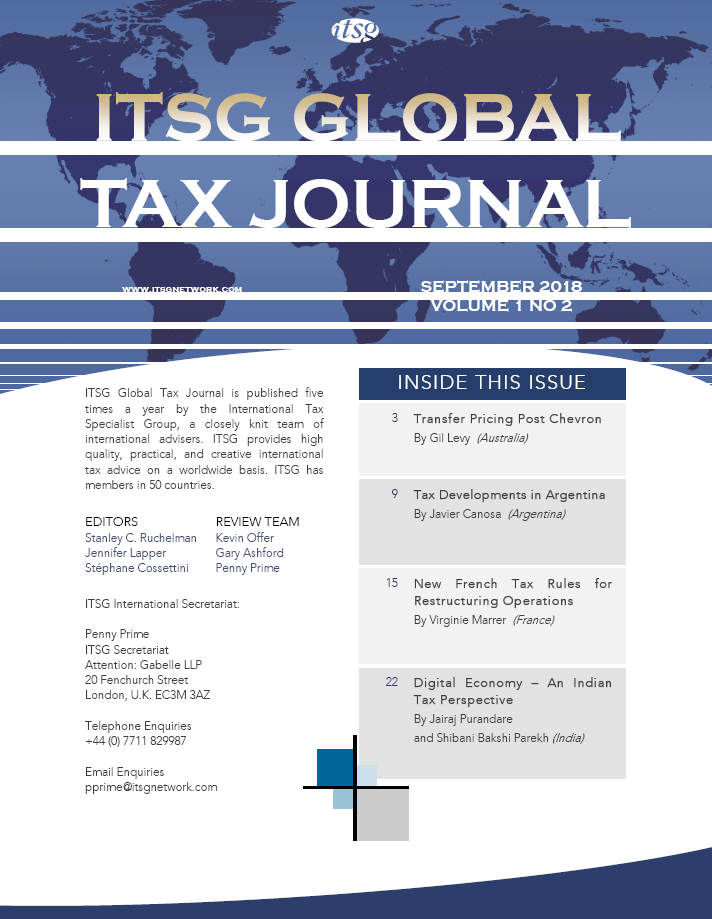Introduction
The term “digital economy” refers to an economy that is based on digital computing technologies and involves the use of digital media of various types. Although, the digital economy is often confused with e-commerce, in reality, digital economy is a very wide term including a variety of software, internet platforms, applications, Internet of things, online advertising, cloud computing, crypto currencies, advanced robotics, electronic business processes, e wallets and online payment services, etc. apart from e-commerce transactions.
Digital economy in India
The digital economy continues to make impressive advances across the globe and India is among the leaders in this space.
The landmark event of demonetization of currency in India in November 2016 saw a spur in the use of internet banking, plastic money, and e-wallets to make cashless payments. This was followed by the introduction of the Goods and Services Tax (“G.S.T.”) in July 2017, which mandates that all records and documentation are to be updated on the online portal.
Based on press reports, the Economic Affairs Secretary of India expects that the digital economy in India may cross the USD 1 trillion mark by the year 2022 and may even constitute half of the total economy by 2030.
Taxation challenges in the digital economy
With the increasing advances in digitization across various industries around the globe, there has been a significant increase in online transactions in the past few years, especially e-commerce transactions. In a borderless digital economy, it is possible to target a large volume of consumers and to undertake business activities in a foreign jurisdiction without establishing a place of business or a physical presence. As a result, tax administrations in most countries have not been able to keep pace with the advances of digitization and several difficulties can arise in the taxation of the digital economy, more so in the case of cross-border transactions. The important task that awaits completion by tax authorities is the adoption, on a global basis, of an acceptable method of allocating taxing rights among various jurisdictions involved in a digital transaction.
Taxation challenges in the digital economy from an India perspective
As per the provisions of the Indian tax law, non-residents are subject to tax only in respect of the income received in India or income sourced in India. Generally, business income of non-resident entities is taxed in India only if where a business connection or Permanent Establishment (“P.E.”) exists in India. If sufficient connection of a P.E. exists, net business income of non-residents are taxable at the base rate of 40% in case of corporate entities and at 30% in case of non-corporate entities. However, if the income of the non-resident is in the nature of specific items of income such as royalties, fees for technical services, capital gains, or interest, specific rates of gross basis tax are applicable.
Since the digital model of business is quite different from traditional business and there is greater reliance on the use of intangibles, it is not easy to determine whether a foreign entity has a sufficient business connection or P.E. in another country by applying the existing tests under the domestic tax law or tax treaties. In fact, this is not a problem unique to India; tax authorities in most countries are grappling with this issue, France and Italy have adopted legislation, and proposals have been floated by the European Commission.
In view of the above, India has recently introduced certain measures in its domestic tax law to bring certain digital transactions under the tax scanner, based on the Base Erosion and Profit Shifting (“B.E.P.S.”) recommendations of the Organisation for Economic Co-operation and Development (“O.E.C.D.”). These are discussed below:
- Equalization Levy
The Equalization Levy (“the Levy”) was introduced in India with effect from 1 April 2016, following the recommendations of the O.E.C.D. B.E.P.S. Action 1. The Levy is intended for certain Business-to-Business transactions in India. It will be charged at the rate of 6% applied to the consideration payable for online advertisement, provision of digital advertising space or any other facility or service for the purpose of online advertisement. The Indian tax authorities have the power to apply this charge to other services. As of 31 August 2016, the tax has not been applied to other services. Nonetheless, a general expectation exists that the scope of the tax will be expanded gradually to apply to other services.
The Levy is applicable to the consideration for specified online advertising services payable to a non-resident by (i) a person who is resident in India and carrying on business or a profession or (ii) a person who is not resident in India but who has a P.E. in India. Note, however, if the consideration for the specified services is payable to a non-resident having a P.E. in India and the services are connected to the P.E., the Levy will not be applicable. As can be seen, the Levy is targeted non-residents who provide specified online services that do not maintain a taxable or a business presence in India. Prior to the adoption of the Levy, those non-resident persons were not subject to tax in India in connection with income arising in India.
Further, the Levy is applicable only to payments exceeding an amount of INR 0.1 million (~USD 1,500), which is a low threshold and hence, a large number of online advertising payments could come under the scope of the Levy. The income of the non-resident payee which has been subject to the Levy is exempt from income tax in the hands of the payee in India.
The onus of collection of the Levy is on the payer of the consideration and this amount is required to be withheld by the payer. The payer is required to deposit the Levy so collected with the tax authorities within a specified time and must file a report with the tax authorities. There are penalties for failing to collect or pay over the Levy within the specified time.
The interesting aspect of the Levy is that it has been introduced in the Finance Act, 2016 and not under the provisions of the Indian Income-tax Act. Moreover, the Levy is strictly not in the nature of an “income tax” charged under the domestic tax law and is not imposed on net income of the non-resident taxpayer. Consequently, there may be no foreign tax credit available for the Levy under the provisions of the tax treaty. Hence, this Levy would become a permanent tax leakage for non-residents.
- Expansion of the definition of business connection – Introduction of “Significant Economic Presence”
Under the domestic tax law, a non-resident carrying on a business or profession in India and receiving income from such business or profession is subject to tax in India in respect of such income, provided that a sufficient business connection exists in India. The term “business connection” has not been defined in the domestic tax law. Rather, its meaning has been inferred from various judgments rendered by the courts over a period of time. Based on court rulings, the term “business connection” is generally interpreted as a relation between a business carried on by a non-resident yielding income or profits to the non-resident and some activity in India which contributes to the earning of such income or profits.
Even as per the provisions of the tax treaties entered into by India, a non-resident would be subject to tax in India if it has a P.E. in India. Therefore, to date, digital companies were able to remain outside the scope of Indian tax jurisdiction when activities carried on in India did not constitute a PE.
However, legislation was adopted regarding the existence of “business connection.” As per the legislation, the concept of “Significant Economic Presence” can be used in defining the existence of a business connection in the context of the digital economy. A non-resident having Significant Economic Presence in accordance with the provisions of the domestic tax law would be considered as having a business connection in India and hence, subject to tax in India.
For this purpose, Significant Economic Presence has been defined to mean:
- Transactions in respect of any goods, services or property carried out by a non-resident in India including provision of software or data that is downloaded in India and that exceeds a certain threshold, which will be notified subsequently or
- Systematic and continuous soliciting of business activities or engaging in interaction through digital means with a certain number of users in India, to be determined subsequently.
Once a “Significant Economic Presence” exists, a digital transaction will be taxed in India even if the agreement for such activities is entered into outside India and the non-resident maintains no place of business in India or renders no services in India. Where a “Significant Economic Presence” exists, the income attributable to such transactions would be taxable in India.
This amendment is a radical divergence from the existing tax provisions where establishment of a physical presence or taxable presence was a prerequisite for taxing the income of a non-resident. It has been specifically brought in to tax the transactions undertaken in the digital economy by non-residents attempting to avoid a business connection in India. However, where India has entered into a tax treaty and the provisions of the tax treaty conflict with the new rules in India, the non-resident may be able to seek relief under the tax treaty, except to the extent the provisions of the Multilateral Instrument (“MLI”) may have modified the result under the treaty.
Possible challenges may be raised to this provision. The threshold for revenue and number of users constituting a Significant Economic Presence is yet to be announced by the tax authorities. The cost of systems required to compute the number of users with whom the non-resident entity has had interactions during the relevant financial year may be unduly burdensome. Moreover, substantial differences may exist between the taxpayer and the tax authorities in defining the level of contact that constitutes an interaction and establishing whether that contact is deemed to be systematic and continuous.
The concept of Significant Economic Presence has been adopted by India based on the recommendations of O.E.C.D. B.E.P.S. Action 1. It is important to note that while the Explanatory Memorandum in respect of the amendments to the income tax law states that the concept of “Significant Economic Presence” is introduced to cover transactions in the digital economy, the actual amendment in the law appears to be applicable to the traditional business model, as well, since the definition of Significant Economic Presence is an inclusive definition that is applicable to transactions in respect of any goods, service or property, including download or data or software, etc.
In view of this amendment, it would be interesting to see how the tax authorities would view the activities of foreign companies which provide various online booking facilities in India. and have their servers outside India. If electronic payments are made by Indian customers and routed to the foreign company’s offshore server, the Indian tax authorities might feel justified in contend that the payments made to the foreign entity are for the purpose of bookings in India and therefore, the source of income is in India.
In addition to the above, the digital economy is distinctly characterized by heavy reliance on intangibles. At present, there are no separate rules in the Indian tax law in respect of intangibles and especially, in the context of non-residents carrying out business activities in India through digital means. However, judging by the amendments to the tax law in the recent past, it may not be a surprise if provisions to tax intangibles in the digital business model are introduced with general application in the Indian tax law.
- Key court rulings
Over the last few years, the Indian tax authorities have started scrutinizing transactions in the digital space more closely, as evidenced by the increased level of litigation in this regard. Some of the key decisions rendered by courts recently are discussed below:
- Flipkart India Pvt Ltd (April 2018)
This ruling was delivered by the Income Tax Appellate Tribunal (i.e. the second level appellate authority) in Bangalore and pertains to the taxpayer’s income in fiscal year 2014-15. The issue under consideration was the deductibility of discounts on sales for determining the business income subject to tax.
The taxpayer, an Indian company, was engaged in the business of wholesale trade. It provided large discounts to its customers (i.e., retail sellers) and incurred significant losses. The retail sellers in turn sold the goods on flipkart.com, the internet platform. The taxpayer’s argument on the deductibility of these discounts was that the e-commerce sector was at an early stage in India were offered to encourage sales volume.
The Indian tax officer took the view that selling the goods at a loss was not normal business practice and that this particular strategy was followed to establish customer goodwill and brand value in the long run, reaping the benefits in subsequent years. The tax officer observed that the profit foregone by the taxpayer was actually the expenditure incurred for the creation of intangibles and should be characterised as a capital expenditure. The tax officer further observed that two venture capitalists invested in the shares of the taxpayer at a premium during the relevant fiscal year. According to the tax officer, such high share premium was justified only because of the asset base created by the taxpayer in the form of brand value, which is an intangible asset. Hence, the tax officer did not allow a deduction for the discount in computing the taxpayer’s income.
The appellate authority ruled in favour of the taxpayer. Where a trader transfers goods to others at a price that is less than charged by competitors, and the transaction is bona fide, the tax officer cannot take into account prices charged by others, ignoring the actual price realised from the transaction. Further, since the taxpayer did not incur any expenditure to acquire marketing intangibles, there was no evidence of creation of intangibles. The appellate authority also noted that a tax officers job is to examine the profit or loss reported in the books of account of the taxpayer and cannot ignore the book results of the taxpayer and resort to estimating the income of the taxpayer in a different manner.
- MasterCard Asia Pacific Pte Ltd (June 2018)
This ruling was rendered by the Authority for Advance Rulings (“A.A.R.”) in the case of a taxpayer incorporated in Singapore. The taxpayer, MasterCard Asia Pacific Pte Ltd (“M.A.P.L.”) was engaged in carrying out transaction processing and payment related services.
M.A.P.L. entered into agreements with customer banks and financial institutions in India to provide services relating to electronic authorization, clearing, and settlement of payments for transactions made through cards. The processing took place on the MasterCard Worldwide Network. In order to access this network, a MasterCard Interface Processor (“M.I.P.”) is installed at the customers location in India. These M.I.P.s are owned by the Indian subsidiary of M.A.P.L. The issue before the A.A.R. was whether a P.E. existed for M.A.P.L. in India.
The A.A.R. ruled, that the automatic equipment installed in the customers premises are in the nature of a P.E. that causes M.A.P.L. to be taxed in India in connection with the revenue generated through the use of the equipment. The A.A.R. observed that in order to constitute a fixed place P.E., it is not necessary that the equipment should be fixed to the ground; it is sufficient that the equipment remains on a particular site, in accordance with the O.E.C.D. Commentary on Article 5 (“Permanent Establishment”). Further, the M.I.P.s were permanently located in India and the fact that neither the sites nor the M.I.P.s were owned by M.A.P.L. are not relevant. As long as M.A.P.L. has a certain space at its disposal, it is sufficient to create a P.E. Further, the A.A.R. observed that any payment processing activities carried out by personnel in India were not preparatory or auxiliary activities. They went to the core of the revenue raising activity.
- Google India Pvt Ltd (October 2017)
This ruling was issued by the second level appellate authority in Bangalore. The taxpayer, Google India Pvt Ltd was an Indian company and tax resident in India. Google India was granted the marketing and distribution rights of the Adword program for advertisers in India. The principal under the distribution agreement was Google Ireland. Google India made payments to Google Ireland under the Adword agreement without the collection of withholding taxes. According to Google India, the payments made to Google Ireland were for the use of advertising space. The tax officer held that the payments were in the nature of royalties and were subject to withholding tax.
The appellate authority observed that the agreement between Google India and Google Ireland was not merely an agreement for the sale of advertising space. The payment constituted consideration paid by Google India for the use of a patented algorithm of Google Ireland to decide which advertisement was to be shown to a particular user who performed a search on the Google website. The licensed technology allowed Google India to conduct a focused marketing campaign for the products and services of Googles customers with the help of technology. The search engine technology, associated software, and other features constituted intellectual property owned by Google Ireland. Therefore, the payment by Google India for use of these tools for accepting advertisements was in the nature of a royalty.
- Localized Record Keeping
Apart from the income tax provisions in India, certain guidelines issued by other regulatory authorities in India in the context of the digital economy may also have a bearing on Indian income tax exposure.
The Reserve Bank of India (“R.B.I.”), which is the regulatory body for exchange control matters in India, issued directions in April 2018 to payment system operators in India requiring that the entire data relating to payment systems operated in India should be stored on a system physically located in and only in India. Covered data includes the end-to-end transaction such as the details; the information that is collected, carried, or processed as part of the payment message; and the instruction. For the foreign segment of the transaction, if any, the data can also be stored in the foreign country, if required. Further, payment systems operating in India are required to comply with this requirement within six months from the issue of the directions and report the necessary compliance to the R.B.I. latest by 15 October 2018.
Earlier this year, press reports indicated that amendments to the National Telecom Policy of India were under consideration whereby all telecom companies hosting data of Indian citizens and entities may be required to set up their servers in India by 2022.
The Indian Government has appointed a committee chaired by a retired judge of the Supreme Court of India to provide recommendations on data protection. A report was submitted in July containing a broad framework for a data protection law in India.
On the subject of data localization, the report states that every company processing personal data storage must keep at least one copy of personal data on a server or data centre located in India. The Indian Government would be authorized to identify certain categories of personal data as critical personal data that can be processed only on a server or data centre located in India. When implemented, the data protection policy is likely to bring more financial companies under the ambit of data localization by categorizing most types of financial data as sensitive personal data.
In light of the above, it is likely that India may have a comprehensive data protection law soon. Global entities operating in the digital economy may be required to set up servers in India in order to store data pertaining to Indian citizens/entities/transactions. Indian tax authorities may view these servers Indian P.E.s of the foreign entity, thereby exposing the foreign entity to taxation in India.
- Flipkart India Pvt Ltd (April 2018)
Conclusion
It can be seen from the foregoing discussion that various dimensions exist regarding the taxation of digital business. The scope of regulation is expanding and non-tax regulations regarding localized record-keeping laws may yield greater exposure to business taxation if local data storage creates a P.E. The Task Force on Digital Economy constituted by the O.E.C.D. B.E.P.S. Committee has issued an interim report on the tax issues that confront business and tax authorities in connection with tax policy. A final report on tax challenges for the digital economy is expected by 2020. It will be a matter of a few years before uniform in tax policy is adopted globally. Until then, Indian tax policy will develop based on the local views and concerns of Indian policy makers.

 Login
Login





















































